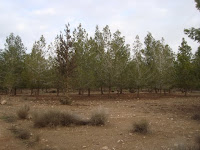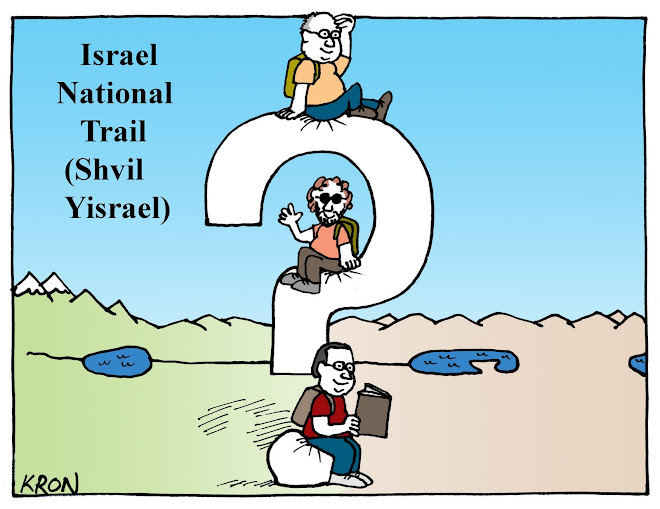


The walk from Dvir to Pura is only an easy 10 km, far too short for us intrepid shvillers. We decided to add on an extra 4 km, starting at the entrance to the Dvir Forest. These first four kilometres had us walk with the J.N.F planted pine forest to our right, green wheat fields to our left. At some point Mr. shvil painter decided that this was too monotonous even for him, so he led us briefly into the forest and out on to the other side. Now the forest was on our left and the green wheat fields on our right. This is not the badlands area of the previous day, so the wheat fields are expansive, at least by Israeli, if not American or Australian standards. At least it was green and pleasant. Come late spring or summer it would be unbearably hot and unbearably brown\grey and boring.


At some point in the forest we saw piles of rocks stacked in such a way that it wasn't certain if it was deliberate, like some sort of memorial, or a demolished building, or an ancient ruin. We didn't stop to check it out, though in retrospect, perhaps we should of. Any point of interest would have been welcome.
We had a slight dilemma as to what pace to set for ourselves today. On the one hand, we'd set out relatively early, seeing no reason to lounge around the Lahav Hilton, nor was there a reason to drag our feet as we wanted to get home to enjoy the weekend with our families. In general we tend to walk quickly and as I wrote in the previous chapter, we'd set a cracking pace the day before. We didn't, want to walk at that same pace today. We did, however, have to keep our eye on the weather. The sky was grey and the forecast was for rain, so we couldn't dawdle too much. Here and there we encountered very light drizzle, nothing that really worried us, but certainly warned us that it could at any point get heavier.
So after 4 relaxed kilomtres we came to kibbutz Dvir. Garry was quite excited. Kibbutz Dvir owns a plastic factory that makes large sized products and therefore has large injection moulders. This is a field that Garry apparently works with in his non-shvil business life.


From here on, we would have Nachal Shikma to our right and green wheat fields to our left. It says something when the highlight of the day was Yoni pulling a carrot out of the ground as we passed by a carrot field. We cleaned off the clumpy mud and shared it, unpeeled and au natural, between the five of us (the Hochberg Brothers were sharing this exhilarating leg with us). Whoopee!!!
Sometimes trail markers take the form of small metal signs hammered into the ground, painted with the white\blue\orange colours. They are not deeply anchored and we've seen them upended on a few occasions. .At some point we saw such a metal shvil marker leading us across Nachal Shikma on a path that seemed away from our general walking direction. This wouldn't be the first time that the shvil has taken us on either an understood or vague detour, so we shrugged and went in the direction of the sign. Soon enough we came to realise that the metal sign was in the wrong place. It seems that a shviller before us had understandably been bored by the walking , picked up the sign and placed it in a position that would lead those coming after astray. A pretty lame joke and thankfully only the first time in 2 years on the shvil that we'd encountered a moveable marker deliberately moved to the wrong place. Being the Good Samaritans that we are, we uprooted the metal sign and put it into the ground in a place that it should have been, with the nachal on our right and the fields on our left.


And that's about it. This was a section that connected point A to point B. You put a tick in the box and move on to the next leg. We were a little tired and a little stiff after 26 km in under 24 hours. It raises an interesting question that I don't think there is any clear answer to. What is our comfort zone? How many kilomtres can we walk comfortably? Clearly terrain, weather and logistics are factors that prevent any one clear answer, but I think that we acknowledge that 18 kilometres is what we like to do in a one day hike. More than that in one go may start to look difficult. 26 very easy km in 24 hours was not hard and I think another 4 km would have been well within our abilities. We are in agreement that as long as the walking is easy and the weather ideal, we want to push ourselves as much as we can within our comfort zone or even slightly past it.



We got back to Yoni's car 5 minutes before the rains started, a sure sign that once again the shvil gods were looking out for us. In celebration of our good fortune and early finishing, we decided to offer up a sacrifice to those same shvil gods and stopped off for hummus at Abu No-Name, who sells his product from a caravan in a car-park close to Lachish. The hummus may not have been up to the standard of what we're used to in the Galil, but all the same, was accepted by the gods as an appropriate offering.










No comments:
Post a Comment